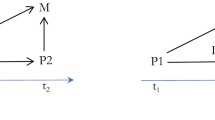Abstract
It is generally assumed that everything that can be said about dependence with the notion of strong global supervenience can also be said with the notion of strong supervenience. It is argued here, however, that strong global supervenience has a metaphysically distinctive role to play. It is shown that when the relevant sets include relations, strong global supervenience and strong supervenience are distinct. It is then concluded that there are claims about dependence of relations that can be made with the global notion of strong supervenience but not with the “local” (individual) one.
Similar content being viewed by others
Notes
Here is Kim’s (1987) definition: A-properties strongly supervene on B-properties if and only if for any possible worlds w 1 and w 2 and any objects x in w 1 and y in w 2, if x in w 1 is B-indiscernible from y in w 2, then x in w 1 is A-indiscernible from y in w 2.
Global supervenience was first introduced by Horgan (1982) as a relation between the B-properties and A-properties of the entire objects in any possible world.
Bennett (2004) also demonstrates that if the A-properties are intrinsic there is no need to enlarge the B-base: she proves that SGS and SIS of A on B are equivalent whenever the A-properties are intrinsic.
Kim (1993) examines several ways to account for relations, but he is satisfied with none of them. He finally (p. 164) settles on the notion of isomorphism over sets of individuals, which is really yet another version of global supervenience. Indeed, I think that the way to make Kim’s suggestions adequate is in terms of SGS.
See Bennett and McLaughlin (2005) Sect. 5.3.
See Kim (1993) who argues for this point when discussing relations.
Hoffmann and Newen (2007) argue that a B-base that includes all the intrinsic and extrinsic properties (and relations) is too weak, as it does not distinguish between the relevant and irrelevant B-properties. I discuss this argument elsewhere (Shagrir, forthcoming).
References
Bennett, K. (2004). Global supervenience and dependence. Philosophy and Phenomenological Research, 68, 501–529. doi:10.1111/j.1933-1592.2004.tb00364.x.
Bennett, K., & McLaughlin, B. (2005). Supervenience. Stanford Encyclopedia of Philosophy. http://plato.stanford.edu/entries/supervenience/.
Hoffmann, V., & Newen, A. (2007). Supervenience of extrinsic properties. Erkenntnis, 67, 305–319. doi:10.1007/s10670-007-9073-y.
Horgan, T. (1982). Supervenience and microphysics. Pacific Philosophical Quarterly, 63, 29–43.
Kim, J. (1984). Concepts of supervenience. Philosophy and Phenomenological Research, 45, 153–176. doi:10.2307/2107423.
Kim, J. (1987). ‘Strong’ and ‘global’ supervenience revisited. Philosophy and Phenomenological Research, 47, 315–328. doi:10.2307/2107631.
Kim, J. (1993). “Postscripts on supervenience”, in his supervenience and mind (pp. 161–171). Cambridge: Cambridge University Press.
McLaughlin, B. (1997). Supervenience, vagueness, and determination. Philosophical Perspectives, 11, 209–230.
Paull, C. R., & Sider, T. R. (1992). In defense of global supervenience. Philosophy and Phenomenological Research, 52, 833–854. doi:10.2307/2107913.
Shagrir, O. (2002). Global supervenience, coincident entities and anti-individualism. Philosophical Studies, 109, 171–195. doi:10.1023/A:1016224703009.
Shagrir, O. (forthcoming). Concepts of supervenience revisited.
Sider, T. R. (1999). Global supervenience and identity across times and worlds. Philosophy and Phenomenological Research, 59, 913–937. doi:10.2307/2653562.
Sider, T. R. (2008). Yet another paper on the supervenience argument against coincident entities. Philosophy and Phenomenological Research, 77, 613–624.
Stalnaker, R. (1996). Varieties of supervenience. Philosophical Perspectives, 10, 221–241.
Acknowledgements
Thanks to Ted Sider and two anonymous referees. This research was supported by The Israel Science Foundation, grant 725/08.
Author information
Authors and Affiliations
Corresponding author
Rights and permissions
About this article
Cite this article
Shagrir, O. Strong Global Supervenience is Valuable. Erkenn 71, 417–423 (2009). https://doi.org/10.1007/s10670-009-9187-5
Received:
Accepted:
Published:
Issue Date:
DOI: https://doi.org/10.1007/s10670-009-9187-5




